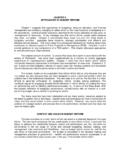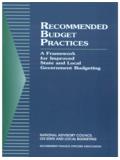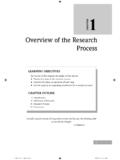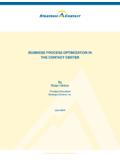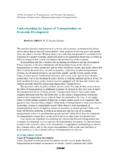Transcription of Public Participation and the Budget Cycle
1 Public Participation and the Budget Cycle : Lessons from Country Examples Lindsey Marchessault 1 Contents Executive Summary .. 2 The Case for Participation and the Need for Guidance .. 3 The Executive: Participation in Budget Planning, Formulation and Implementation .. 5 The Legislature, Participation and the Budget Process .. 8 Participation and Auditing .. 11 Other Efforts: Open Contracting, Environmental Assessments, and Constitutional Convention 14 Open Contracting: Increasing Public Participation in Public Contracting .. 14 Environmental Impact Assessments .. 15 Constitutional Convention Model .. 17 Lessons for Policy-Makers, Informing the GIFT Zero Draft Guidelines .. 17 2 Executive Summary Public Participation in fiscal processes is a relatively new phenomenon. However, governments are increasingly adopting such processes.
2 The value proposition underlying these efforts is that disclosure and Participation are mutually reinforcing drivers of accountability and improved decision making. GIFT is currently developing a guidance note on Public Participation in fiscal policy. The objective is to help policy makers to create effective opportunities for Public Participation . In support of this goal, this paper explores diverse country examples of Public Participation to extract and synthesize lessons of good practice. Several core principles and features of effective, transparent and accountable Participation practices are distilled. First, the entry points and process leaders for Public Participation must be identified within the fiscal processes of the existing legal framework. In the budgeting Cycle , these entry points occur during long term planning exercises, as well as medium-term and annual Budget formulation processes led by the executive (either Finance or a sector agency); during the enactment of the Budget by parliament; during the implementation of the Budget by the sector agencies; and during the audit and performance evaluation.
3 The Zero Draft of the GIFT guidelines has identified several additional entry points for Public Participation in fiscal processes as well. Second, the examples demonstrate the importance articulating a clear objective for Public Participation from the onset in order to maximize Public interest and engagement opportunities. The Budget typically covers thousands of expenditure line items and it would be untenable to seek Public engagement on every item. Therefore, it is important to either choose the programs for Public consultation that citizens care about and where a Public dialogue will be most valuable (as happens in medium term planning in Korea and audit planning in the Philippines p. 14) or to put in place open processes that enable the Public to determine the priorities (as happens in the ground up budgeting program in the Philippines p.)
4 8 and the assemblies-system in Rio Grande do Sol, Brazil p. 8). Likewise, it is important to decide whether the objective of the Participation is to inform the Public , get their feedback, obtain their input, collaborate with them, or empower them to make decisions. After objectives are defined, it is necessary to determine the targeted participants. Participants vary from the general Public (such as in Rio do Sol, Brazil p. 8) to individuals with specific knowledge or expertise (such as in the advisory council of Korea p. 7). Regardless of how participants are selected, in open Participation processes it is important that a narrow perspective of voices do not dominate the conversation (and that marginalized but affected voices are included). In more restricted consultation processes, selection criteria should be established that are fair, inclusive and well-documented (for example, the selection process of the Irish constitutional convention p.
5 20). Once participants are chosen, it is important to consider which methods of engagement will be best to achieve the articulated the objective. Examples include the creation of working groups in the Irish Convention p. 20, commissions in South Africa p. 6, Public parliamentary hearings and written submissions in Canada p. 10, conferences in Korea p. 7, Public assemblies and voting in Brazil p. 8, hotlines in South Africa p. 9 and Korea p. 10, and joint working teams in the Philippines p. 14. Some methods may be more appropriate to certain entry points than to others. Country examples in this report also reveal several recurrent features that seem to correlate with successful Public Participation . First, a clearly articulated framework helps to manage expectations of participants and helps the government team to understand and execute the process.
6 These rules may be established in laws, guidelines, and, for collaborative approaches with CSOs, MOUs are particularly relevant (such as in the participatory auditing program in the Philippines p. 14 or contract monitoring efforts p. 17). Second, Participation must be adequately timed within the deadlines imposed by the existing legal framework. If there is sufficient time at the beginning of Budget formulation, processes can be held in multiple cities, with multiple hearings, press releases, and online discussions, as the examples from the 3 Canadian legislature p. 10 and the Rio Grande do Sol executive p. 8 have shown. With less time, more condensed options, like the Korean process p. 7, may be more appropriate. In addition, a high Participation target will cost more and funding must be secured for these efforts, whether from donors or from the government.
7 Furthermore, there is also a need for an adequate number of competent staff to represent the government in these processes. Third, Public Participation benefits greatly from professional facilitation to help manage the process, to channel it productively, and to manage potential conflict. Similarly, a communication strategy is needed to ensure that affected stakeholders know about and understand the process. ICT tools including websites and social media are useful to share the necessary background information with the Public . They can also enable submissions to be received from a wider segment of society. Fourth, reports and media attention on the impact of Participation can build trust and legitimacy, and create incentives for further engagement. The opposite also holds: stakeholders will likely become disengaged if they participate but do not know how their input is used or see no results from their collaboration.
8 In light of these examples, it would be beneficial for the GIFT guidelines to outline the entry points for Public Participation in fiscal processes, the appropriate sponsoring agency of government, the options for participant selection, and the design features of Public Participation processes that would be relevant according to the entry point (particularly in light of the spectrum of engagement objectives). In order to effectively outline such guidance, some additional research might be useful to inform the guidance note with country-based examples, process-related checklists, and even template memoranda of understanding for collaboration between government agencies and non-state actors (perhaps in a second document). In addition, the zero draft could be complimented by adding reference to the above described cross-cutting features of good practice.
9 With these elements in place, GIFT can create a resource for governments and their stakeholders that will assist them to craft truly effective opportunities for Public Participation . The Case for Participation and the Need for Guidance Public Participation in fiscal processes is a relatively new phenomenon. However, governments are increasingly adopting such processes in order to enhance their The value proposition underlying Public Participation processes is that disclosure and Participation are mutually reinforcing drivers of accountability. If given sufficient information, non-government actors can meaningfully participate in fiscal processes and work collaboratively with government stakeholders. This Participation can strengthen these processes in order to achieve better Public financial management outcomes for all.
10 GIFT has recognized the value proposition of Participation in its High Level Principle 10, which states that citizens and civil society organizations (CSOs) should have the right and effective opportunities to participate directly in Public debate and discussion over the design and implementation of fiscal policies. 2 In furtherance of this principle, GIFT is seeking to develop Public Participation standards to guide the implementation of Public Participation processes in fiscal planning and implementation. Entry points for direct Public Participation can be created during each of the stages of the budgeting process (which are laid out in the diagram below). 1 For example, see the Open Budget Survey (Open Budget Partnership, 2012), which explains that while Participation scores remain weak overall on average, several countries are making strides through innovative approaches.


